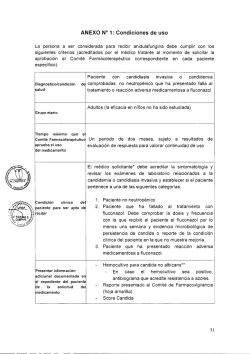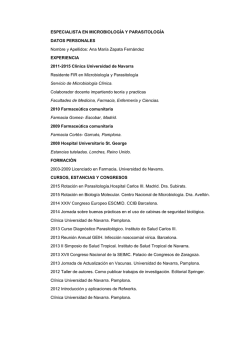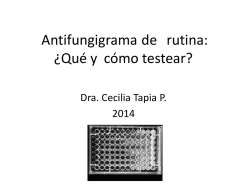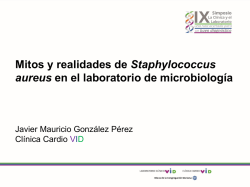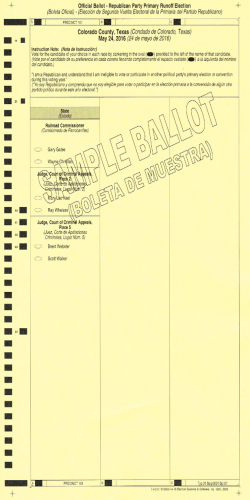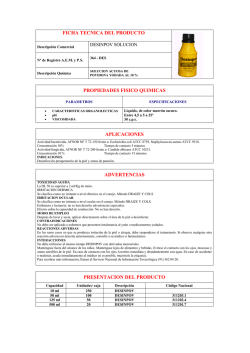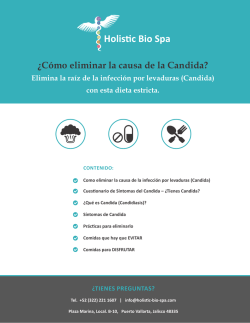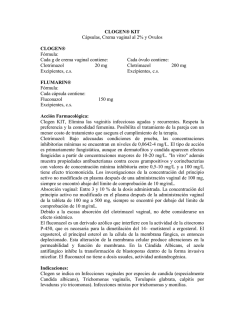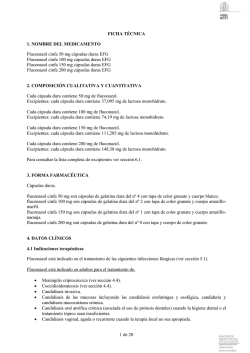
Resumen_Francis_Bert.. - Instituto Nacional de Higiene Rafael
República Bolivariana de Venezuela Instituto Nacional de Higiene “Rafael Rangel” Gerencia de Docencia e Investigación Coordinación de Postgrado Especialización en Micología Médica SUSCEPTIBILIDAD IN VITRO DE CANDIDA SPP., A FLUCONAZOL Y VORICONAZOL, POR LOS MÉTODOS DE MICRODILUCION EN CALDO, ETEST Y SISTEMA AUTOMATIZADO VITEK 2. ESTUDIO COMPARATIVO. Autora: Francis Bertuglia. 2010 RESUMEN La candidiasis invasora (CI) representa la cuarta causa de infección nosocomial a nivel mundial, con una tasa de mortalidad por candidemia entre el 25 y 38%. Se reporta un cambio epidemiológico, en las especies de Candida, de tal forma que la C. albicans (20.7%) fue desplazada por el grupo de Candida no albicans, C. parapsilosis ocupa el primer lugar (44,2%). Es importante conocer y vigilar los cambios de susceptibilidad de Candida spp., a los antifúngicos de uso sistémico a través de técnicas apropiadas y útiles en el laboratorio clínico, para instaurar una terapia antifúngica oportuna. En este estudio se evaluaron 208 cepas de Candida spp., provenientes de la Red de candidemia y vigilancia de la resistencia de los antifúngicos del INHRR, determinando la Concentración Mínima Inhibitoria(CMI) a fluconazol y voriconazol por los métodos de microdilución en caldo (CLSI), Etest y sistema automatizado Vitek 2; siguiendo los procedimientos descritos según los documentos y/o técnicas del fabricante M27-A3 (CLSI), Etest y Vitek 2 respectivamente. Se utilizaron las cepas C.parapsilosis ATCC 22019 y C.krusei ATCC 6258 como control de calidad. Los aislados fueron 100% sensibles para voriconazol por CLSI y Etest; y 99.5% por VITEK 2. El 92.8% de las cepas fueron sensibles por CLSI, 95.2% por Etest y 95.7% por Vitek 2 para fluconazol. Se obtuvo una Especificidad y Concordancia del 100% para Voriconazol por Etest y 99.5% por Vitek 2. Para fluconazol la concordancia fue de 95.6% por Etest y 94.23% por Vitek 2, y una p≤ 0.05.La concordancia entre el método de Etest y Vitek 2 fue de 96%. Se obtuvo una excelente concordancia entre los métodos evaluados, de manera que pueden ser utilizados indistintamente en la detección de susceptibilidad y/o resistencia antifúngica. Palabras claves: Candidiasis, Azoles, Vitek 2, Etest, Microdilución en caldo. i República Bolivariana de Venezuela Instituto Nacional de Higiene “Rafael Rangel” Gerencia de Docencia e Investigación Coordinación de Postgrado Especialización en Micología Médica IN VITRO SUSCEPTIBILITY OF CANDIDA SPP.,TO FLUCONAZOLE AND VORICONAZOLE, BY THE METHODS OF BROTH MICRODILUTION, ETEST AND AUTOMATED SYSTEMS VITEK 2. COMPARATIVE STUDY. Author: Francis Bertuglia. 2010 SUMMARY Invasive Candidiasis(IC) represents the fourth most common cause of nosocomial infection worldwide with a mortality rate of candidemia between 25 and 38%. A epidemiological shift so that the C. albicans (20.7%) have been displaced by the Candida no albicans group, C. parapsilosis is most common species (44,2%). It is important to know and to monitor changes in susceptibility of Candida spp. To systemic antifungal, with use of appropriate techniques in the clinical laboratory, because of the to establish a early antifungal therapy. This study evaluated 208 strains of Candida spp. Surveillance program of Candidemia from the INHRR, determining the minimum inhibitory concentration (MIC) to fluconazole and voriconazole by the broth microdilution methods (CLSI), Etest and Vitek 2 automated system, following the procedure contained in document M27-A3 (CLSI), and the procedure described by the manufacturer to the other methods. Were used strains as quality control C. parapsilosis ATCC 22019 and C.krusei ATCC 6258. The isolates were 100% susceptible to Voriconazole by CLSI and Etest and 99.5% for VITEK 2. The 92.8% of the strains were susceptibility to fluconazol for CLSI, 95.2% by Etest and 95.7% for Vitek2 . Specificity and categorical agreement was100% for Voriconazole by Etest and 99.5% for Vitek 2. For fluconazole the agreement was 95.6% by Etest and 94.23% for Vitek 2, McNemar index <3.8 and p ≤ 0.05.The categorical agreement between the Etest method and Vitek 2 was 96%. CONCLUSION: There is a excellent agreement between the methods evaluated, so that can be used interchangeably in the detection of antifungal susceptibilitytesting. Keywords: Candidiasis, Azoles, Vitek 2, Etest, Broth microdilution. ii
© Copyright 2025
